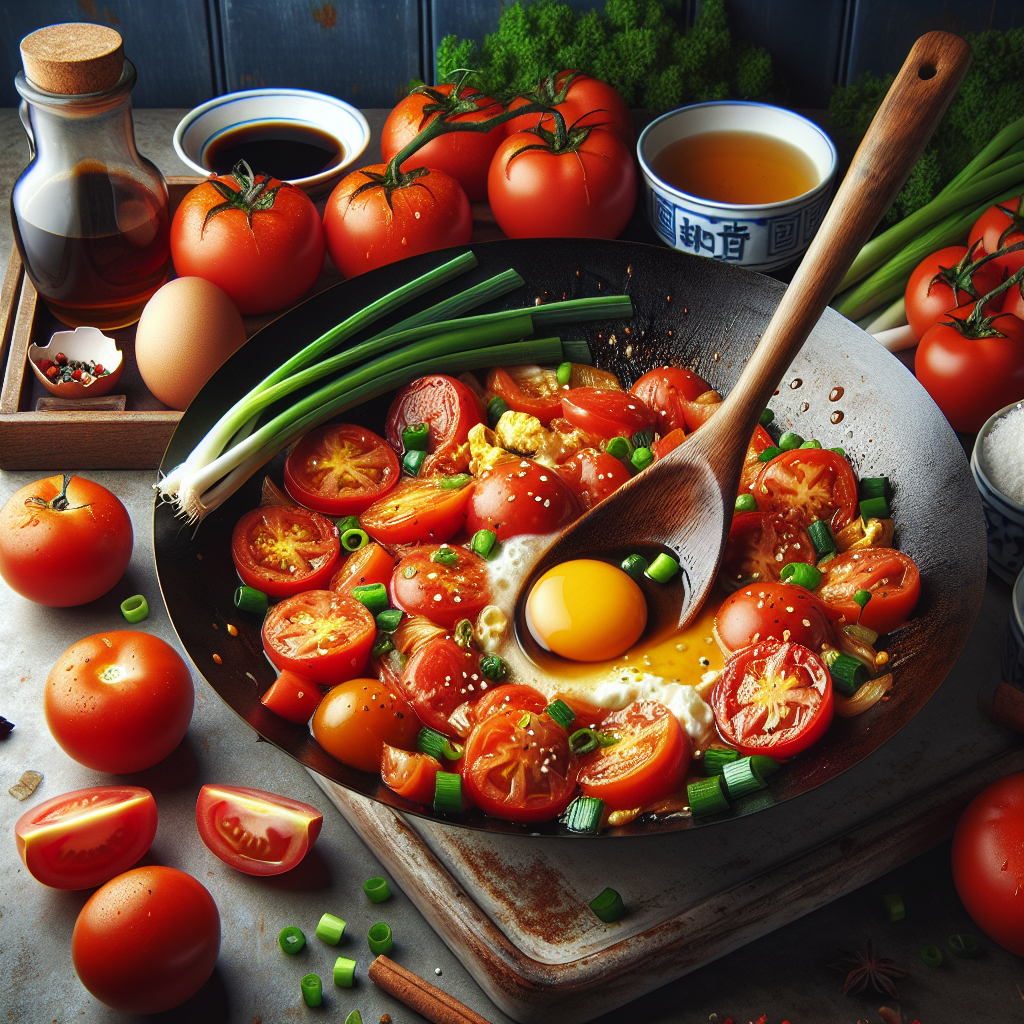
Discover the comfort of Chinese home cooking with this quick and soulful tomato egg stir-fry. This beloved dish combines silky scrambled eggs with juicy tomatoes in a perfectly balanced sauce. Ready in just 15 minutes, it's the ultimate weeknight dinner that brings authentic Chinese flavors to your table.
Ingredients for Authentic Chinese Tomato Egg Stir-Fry (15-Minute Recipe)
- 6 whole Large Eggs
- 4 whole Ripe Tomatoes
- 2 whole Green Onions
- 2 tbsp Vegetable Oil
- 1 tsp Salt
- 1 tsp White Sugar
- 0.5 tsp White Pepper
- 1 tsp Sesame Oil
Instructions for Authentic Chinese Tomato Egg Stir-Fry (15-Minute Recipe)
- Beat 6 whole eggs with 0.5 tsp salt and 0.5 tsp white pepper until well combined
- Cut 4 whole tomatoes into wedges and finely slice 2 whole green onions
- Heat 1 tbsp vegetable oil in a large wok or skillet over medium-high heat
- Pour in the beaten eggs and scramble until just set but still slightly wet. Remove to a plate
- Add remaining 1 tbsp vegetable oil to the wok
- Add the tomato wedges, remaining 0.5 tsp salt, and 1 tsp sugar. Stir-fry for 2 minutes until tomatoes start to soften
- Return eggs to the wok, add 1 tsp sesame oil, and gently stir everything together for 1 minute
- Garnish with the sliced green onions and serve hot with steamed rice
Discover the Comfort of Chinese Tomato Egg Stir-Fry: A 15-Minute Wonder
Growing up in a Chinese-American household, tomato egg stir-fry (番茄炒蛋) was our equivalent of grilled cheese - the ultimate comfort food that could turn any bad day around. This beloved dish combines the silky smoothness of scrambled eggs with the sweet-tangy burst of tomatoes, creating a harmonious blend that's greater than the sum of its parts. What makes this recipe truly special is its simplicity: just 8 basic ingredients transformed into a satisfying meal in 15 minutes. Whether you're a busy professional looking for a quick dinner solution or someone wanting to explore authentic Chinese home cooking, this dish delivers both comfort and flavor without any fuss.
Tips for Perfect Chinese Tomato Egg Stir-Fry Every Time
As a chef who's made this dish countless times, both at home and professionally, I've gathered some crucial tips that will elevate your tomato egg stir-fry game. First, the eggs should be just slightly undercooked when you remove them from the wok - they'll continue cooking when reintroduced to the tomatoes. Think of them as velvety and custard-like rather than dry and crumbly.
For the tomatoes, ripeness is key. Choose tomatoes that are red and ripe but still firm - they'll hold their shape while releasing their natural sweetness into the dish. I often use Roma tomatoes, but any fresh, ripe tomatoes will work beautifully.
Temperature control is crucial: keep your wok or skillet hot enough to create that perfect sear on the eggs, but not so hot that they brown. The goal is golden, fluffy eggs that remain tender and moist.
Don't skip the sesame oil at the end - it adds that authentic finishing touch that makes this dish distinctly Chinese. And remember, while it might be tempting to add more seasonings, the beauty of this dish lies in its simplicity.
Serving Your Chinese Tomato Egg Stir-Fry
Traditional Chinese tomato egg stir-fry is best served immediately, while the eggs are still fluffy and the tomatoes are warm and juicy. A bowl of steamed white rice is the perfect accompaniment, ready to soak up all the savory-sweet sauce. For a complete meal, I recommend serving it family-style alongside some simple stir-fried greens like bok choy or Chinese broccoli.
Each serving (about 1 cup) contains 185 calories, making it a light yet satisfying option. For a more substantial meal, you can double the portion and add a side of your favorite vegetables. Don't forget to garnish with plenty of fresh green onions - they add both color and a fresh crunch that complements the soft textures of the eggs and tomatoes.
A Taste of Home: My Journey with Tomato Egg Stir-Fry
This recipe holds a special place in my heart, taking me back to my grandmother's tiny kitchen in San Francisco's Chinatown. I was barely tall enough to see over the counter when she first taught me to make this dish. "The key," she would say in Cantonese, "is to treat the eggs with respect." I didn't understand what she meant until years later, after countless attempts to recreate her perfect version.
What makes this memory particularly poignant is that this was the first dish I learned to cook completely on my own. During my college years, when homesickness would hit hard, I'd make tomato egg stir-fry in my cramped dorm kitchen. The familiar aroma would draw curious classmates, and soon enough, this simple dish became my way of sharing my heritage with friends from diverse backgrounds. They were always amazed that something so delicious could come from such basic ingredients.
Now, as a professional chef, I still find myself returning to this recipe. It reminds me that sometimes the most meaningful dishes aren't the most complex - they're the ones that tell a story and bring people together.
Smart Substitutions for Your Chinese Tomato Egg Stir-Fry
While this classic Chinese dish is perfect as is, I understand that sometimes you might need to make adjustments. Here are some thoughtful substitutions that won't compromise the authentic flavors:
For the eggs:
- Just egg or other liquid egg substitutes can work for a vegan version, though the texture will be different
- Duck eggs can add a richer flavor (use 4-5 instead of 6)
For the tomatoes:
- Cherry tomatoes (use 12-15) work beautifully when regular tomatoes aren't in season
- Roma tomatoes are an excellent alternative to regular tomatoes
- Canned tomatoes should be a last resort, but if used, drain well and reduce cooking time
For the oils:
- Any neutral oil (canola, grapeseed, sunflower) can replace vegetable oil
- Toasted sesame oil is ideal, but regular sesame oil works too
- Peanut oil adds a subtle nutty flavor that complements the dish
For the seasonings:
- Black pepper can substitute white pepper, though use slightly less
- Coconut sugar or brown sugar can replace white sugar
- Green onions can be swapped with chives or the green parts of leeks
Pro tip: While substitutions are possible, I recommend staying true to the original ingredients for your first attempt. The simplicity of this dish means each ingredient plays a crucial role in achieving that authentic Chinese home-cooked flavor.
Understanding the Nutrition of Tomato Egg Stir-Fry
As a chef who prioritizes both flavor and health, I'm excited to break down the nutritional profile of this beloved Chinese dish. Each serving (recipe serves 4) provides:
- Calories: 185
- Protein: 11g
- Fat: 14g
- Carbohydrates: 6g
- Sugar: 3g
This tomato egg stir-fry is a surprisingly balanced meal that offers several nutritional benefits. The eggs provide high-quality protein and essential amino acids, along with vitamins D and B12. They're also rich in choline, which supports brain health.
The tomatoes contribute lycopene, a powerful antioxidant that becomes more bioavailable when cooked. They're also excellent sources of vitamin C and potassium. The minimal cooking time helps preserve these nutrients while enhancing their absorption.
Green onions add vitamin K and beneficial sulfur compounds, while the small amount of sesame oil provides healthy fats and antioxidants. The moderate calorie count makes this dish suitable for various dietary goals, and it's particularly protein-rich for its calories.
To make this a complete meal, I recommend serving it with brown rice or quinoa for added fiber and nutrients. This would increase the calorie count but provide a more substantial meal while maintaining the healthy profile.
Important Allergy Information for Chinese Tomato Egg Stir-Fry
When serving this dish, it's crucial to be aware of potential allergens. Here's a comprehensive breakdown:
Primary Allergens:
- Eggs (main ingredient)
Secondary Considerations:
- Sesame (from sesame oil)
While this dish is relatively allergen-friendly compared to many Chinese recipes, it's essential to note that both eggs and sesame are among the top allergens in many countries. If you're cooking for others, always disclose these ingredients.
Cross-Contamination Risks:
- If using shared kitchen equipment, be aware of potential cross-contamination with other common allergens
- Many commercial vegetable oils are processed in facilities that also process peanuts and tree nuts
Good news for those with dietary restrictions - this recipe is naturally:
- Gluten-free
- Dairy-free
- Nut-free
- Shellfish-free
- Soy-free (when using pure sesame oil)
Always check ingredient labels, particularly for oils and seasonings, as manufacturing processes can vary.
Storage Tips for Chinese Tomato Egg Stir-Fry
While this dish is best enjoyed fresh off the wok, proper storage can help maintain its quality if you have leftovers. Here's how to keep your tomato egg stir-fry at its best:
Refrigeration:
- Store in an airtight container for up to 2 days
- Allow to cool completely before refrigerating (about 30 minutes)
- Keep at 40°F (4°C) or below
Reheating Guidelines:
- Microwave: 1-2 minutes on medium power, stirring halfway
- Stovetop: 2-3 minutes over medium heat in a non-stick pan
- Add 1-2 teaspoons (5-10ml) of water when reheating to maintain moisture
Not Recommended:
- Freezing (affects texture of both eggs and tomatoes)
- Storing at room temperature for more than 2 hours
Pro Tips:
- If meal prepping, consider keeping the components separate
- Store green onion garnish separately to maintain crispness
- Use glass containers when possible to prevent staining from tomatoes
Frequently Asked Questions About Chinese Tomato Egg Stir-Fry
Why are my eggs turning rubbery? High heat and overcooking are usually the culprits. Remove the eggs when they're just set but still slightly wet. They'll continue cooking when returned to the wok.
Can I make this ahead for meal prep? While possible, this dish is best enjoyed fresh. If meal prepping, I recommend cooking the eggs slightly less than usual to prevent them from becoming overcooked when reheating.
Why add sugar to the tomatoes? Sugar balances the natural acidity of the tomatoes. It's a traditional technique in Chinese cooking that creates harmony in the dish. Feel free to adjust the amount to your taste.
How ripe should the tomatoes be? Choose tomatoes that are ripe but still firm. Over-ripe tomatoes can become too mushy during cooking, while under-ripe ones won't release enough flavor.
What kind of rice pairs best with this dish? Traditional white jasmine rice is classic, but any rice works. For a healthier option, brown rice or cauliflower rice are great alternatives.
Concluding Thoughts on Chinese Tomato Egg Stir-Fry
This humble Chinese tomato egg stir-fry holds a special place in my heart, representing the beautiful simplicity of Chinese home cooking. As someone who grew up watching my grandmother make this dish, I can attest that its magic lies not in complex techniques or rare ingredients, but in the perfect balance of everyday elements.
What makes this recipe truly special is its accessibility - requiring just 15 minutes and common ingredients, it's proof that authentic Chinese cooking can be both simple and satisfying. The silky eggs, sweet-tangy tomatoes, and aromatic seasonings come together to create a dish that's greater than the sum of its parts.
Whether you're a beginner cook or an experienced chef, this recipe offers something valuable - a taste of real Chinese home cooking and a reminder that sometimes the most memorable meals are the simplest ones. Remember, the key to success lies in respecting the ingredients and timing - don't rush the eggs, and let the tomatoes cook just enough to release their natural sweetness.
Give this recipe a try, and I'm confident it will become a staple in your weeknight dinner rotation, just as it has been in Chinese households for generations.
